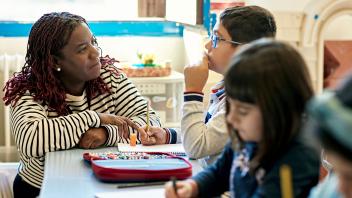Introduction
Many schools use differentiated instruction (Tomlinson, 2001) and Universal Design for Learning (Hall, Meyer & Rose, 2012) to plan flexible reading instruction that meets the needs of diverse learners. Teachers identify and support students by using assessment data to plan instruction and to evaluate program success (Wiggins, 1998; Datnow, Park, & Wohlstetter, 2007; Gersten et al., 2008).
Effective teachers develop daily and weekly routines to guide students. Elementary instruction should use the following:
- evidence-based programs or approaches that address the “big five” — phonics, phonemic awareness, fluency, vocabulary, and comprehension
- explicit instruction with modeling and feedback, using scaffolds to teach new skills — I Do, We Do, You Do
- frequent practice and review for students.
Most elementary teachers spend between 90-120 minutes per day on reading and writing instruction. A daily instructional routine includes whole-class instruction, but it will also have different ways to group students for collaborative and teacher-directed activities, such as small groups, peer partners, or one-on-one instruction.
Types of groupings
Whole group
Whole-class instruction is efficient and allows a teacher to instruct the entire class at one time on a single topic. It is most effective for ensuring that all students are exposed to a specific core standard or focus within the curriculum. Within a whole-group lesson, a teacher can review prior learning, demonstrate new skills, and provide guided practice that requires all students to participate with verbal and physical responses.
The drawback to whole-group instruction is that it may not meet the needs of every student. For some the lesson may be too easy and for others, it may be too difficult. Whole group lessons provide a springboard to plan follow-up targeted instruction with smaller groups.
Small groups
In the elementary grades, it’s common for teachers to allot time between whole-class and small-group instruction for reading. The National Assessment of Educational Progress or NAEP indicated that the use of small groups for reading instruction steadily climbed from 1998 to 2009, with 71% of 4th grade teachers using small groups based on reading ability (Loveless, 2013). A similar trend was noted in kindergarten classrooms participating in the ECLS-K study, with 79% of kindergarten teachers using small groups for reading (Patrick, 2020).
Small groups allow teachers to pull together a few students for targeted instruction. Small groups often take place after whole-group instruction. When establishing groupings, teachers must consider factors such as:
- Total number of groups (1-4 groups)
- Size of the group (e.g., 3-5 students)
- Total minutes allotted to each group (10-30 minutes)
- Frequency of meeting with each group (daily to 2-4 time per week)
- Independent work options (what is the rest of the class doing?)
- How to keep the groups fluid (e.g., the bumblebee group isn’t comprised of the same group of children all year)?
- How you will place children in groups? You can group by reading level, specific skill knowledge, content interest, book choice, and more.
One-on-one
Working with a child individually can result in positive outcomes in learning to read, whether it’s directed by a teacher or a teaching assistant. In the past, one-on-one was considered the “gold standard” for intensive instruction. Indeed, one-to-one instruction promotes targeted, in-depth learning. However, 1:1 tutoring can be expensive and time-consuming, making it beyond the reach of many resource-strapped schools. The good news is that small-group instruction can produce the same and even better results than working one to one (Neitzel, Lake, Pellegrini, & Slavin. 2022).
Peer tutoring or peer partners
One form of successful grouping for reading is to pair two students to read together in the classroom (Fuchs et al 2007; Topping, 1987). Often this involves pairing a weaker reader with a stronger reader. Both students take turns reading a common text and offer one another corrective feedback when needed. This type of pairing allows both students to read for fluency and provides more support than reading alone.
Managing the ELA block
Most U.S. schools allot between 90-120 minutes for reading instruction across grades K-5. The chart below provides an example of how that time might be allotted across a typical literacy block for Tier 1 instruction.
| Gr K-1 | Gr 2-3 | Gr 4-5 | |
|---|---|---|---|
| Whole Group Reading | 15-20 min | 10-15 min | 10-15 min |
| Small Group/Partner Reading | 30 min | 30-40 min | 30-40 min |
| Whole Group Writing | 15-20 min | 10-15 min | 10-15 min |
| Small Group/Partner Writing | 15-20 min | 20-30 min | 20-30 min |
| Total | 120 min | 90-120 min | 90-120-min |
Making room for writing
Writing reinforces reading — especially spelling and comprehension. Try to weave writing practice throughout the school day and in all of the content areas, not just the ELA block. Get tips on how to build writing into your daily instruction
Learn more about instructional routines and grouping
Shanahan on Literacy
Making Whole Class Work More Effective
Shanahan on Literacy
Should Reading Be Taught Whole Class or Small Group?
Shanahan on Literacy
What Should Small Group Reading Instruction Look Like?
Shanahan on Literacy
To Group or Not to Group — That Is the Question
Right to Read
Differentiation Done Right: How “Walk to Read” Works
Differentiated Instruction
Grouping Students Who Struggle With Reading
Curriculum and Instruction
Cracking the Code: How and Why Big Horn Elementary School Went All-In with Structured Literacy
Guides and Toolkits
Using Instructional Routines to Differentiate Instruction: A Guide for Teachers
Differentiated Instruction
Differentiated Instruction for Reading
Learning Disabilities









